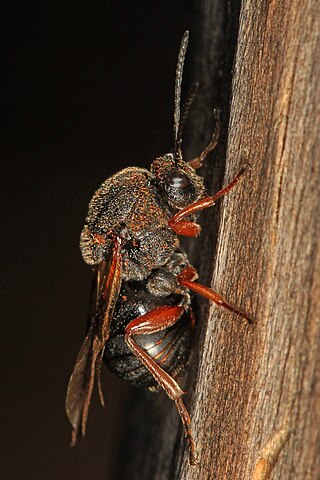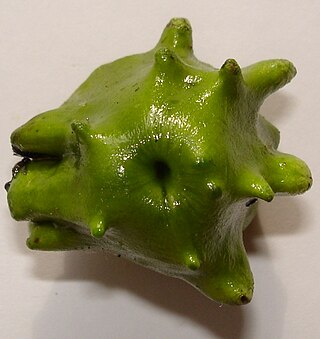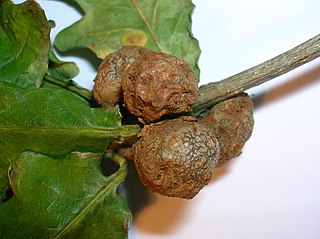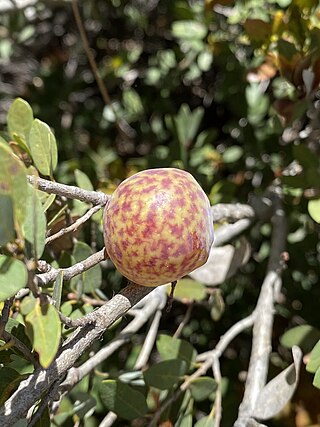
Galls or cecidia are a kind of swelling growth on the external tissues of plants, fungi, or animals. Plant galls are abnormal outgrowths of plant tissues, similar to benign tumors or warts in animals. They can be caused by various parasites, from viruses, fungi and bacteria, to other plants, insects and mites. Plant galls are often highly organized structures so that the cause of the gall can often be determined without the actual agent being identified. This applies particularly to some insect and mite plant galls. The study of plant galls is known as cecidology.

Gall wasps, also traditionally calledgallflies, are hymenopterans of the family Cynipidae in the wasp superfamily Cynipoidea. Their common name comes from the galls they induce on plants for larval development. About 1,300 species of this generally very small creature are known worldwide, with about 360 species of 36 different genera in Europe and some 800 species in North America.

Oak apple or oak gall is the common name for a large, round, vaguely apple-like gall commonly found on many species of oak. Oak apples range in size from 2 to 4 centimetres in diameter and are caused by chemicals injected by the larva of certain kinds of gall wasp in the family Cynipidae.

Andricus quercuscalicis is a gall wasp species inducing knopper galls.

Andricus kollari, also known as the marble gall wasp, is a parthenogenetic species of wasp which causes the formation of marble galls on oak trees. Synonyms for the species include Cynips kollari, Andricus quercusgemmae, A. minor, A. indigenus and A. circulans.

Andricus foecundatrix is a parthenogenetic gall wasp which lays a single egg within a leaf bud, using its ovipositor, to produce a gall known as an oak artichoke gall, oak hop gall, larch-cone gall or hop strobile The gall develops as a chemically induced distortion of leaf axillary or terminal buds on pedunculate oak or sessile oak trees. The larva lives inside a smaller hard casing inside the artichoke and this is released in autumn. The asexual wasp emerges in spring and lays her eggs in the oak catkins. These develop into small oval galls which produce the sexual generation of wasps. A yew artichoke gall caused by the fly Taxomyia taxi also exists, but is unrelated to the oak-borne species. Previous names or synonyms for the species A. fecundator are A. fecundatrix, A. pilosus, A. foecundatrix, A. gemmarum, A. gemmae, A. gemmaequercus, A. gemmaecinaraeformis and A. quercusgemmae.

Cola-nut galls develop as a chemically induced distortion of leaf axillary or terminal buds on pedunculate oak or sessile oak trees, caused by the agamic gall wasp Andricus lignicola which lays single eggs within leaf buds using their ovipositor. A previous name or synonym for the species A. lignicola is A. lignicolus and A. venheurni.

Andricus is a genus of oak gall wasps in the family Cynipidae.

Biorhiza pallida is a gall wasp species in the family Cynipidae. This species is a member of the tribe Cynipini: the oak gall wasp tribe. Cynipini is the tribe partially responsible for the formation of galls known as oak apples on oak trees. These are formed after the wasp lays eggs inside the leaf buds and the plant tissues swell as the larvae of the gall wasp develop inside. This wasp has a widespread distribution within Europe.

Biorhiza is a genus of gall wasps in the family Cynipidae in the tribe Cynipini: the oak gall wasp tribe. Cynipini is the tribe partially responsible for the formation of galls known as oak apples on oak trees. These are formed after the wasp lays eggs inside the leaf buds and the plant tissues swell as the larvae of the gall wasp develop inside.

Cynipini is a tribe of gall wasps. These insects induce galls in plants of the beech and oak family, Fagaceae. They are known commonly as the oak gall wasps. It is the largest cynipid tribe, with about 936 to 1000 recognized species, most of which are associated with oaks. The tribe is mainly native to the Holarctic. Cynipini wasps can act as ecosystem engineers. Their galls can become hosts of inquilines, and the wasps themselves are hosts to parasitoids.

Andricus quercuscalifornicus, or the California gall wasp, is a small wasp species that induces oak apple galls on white oaks, primarily the valley oak but also other species such as Quercus berberidifolia. The California gall wasp is considered an ecosystem engineer, capable of manipulating the growth of galls for their own development. It is found from Washington, Oregon, and California to northern regions of Mexico. Often multiple wasps in different life stages occupy the same gall. The induced galls help establish complex insect communities, promoting the diversification in niche differentiation. Furthermore, the adaptive value of these galls could be attributed their ecological benefits such as nutrition, provision of microenvironment, and enemy avoidance.

Amphibolips is an American genus of gall wasps in the family Cynipidae. There are about 57 described species in the genus Amphibolips with several others still undescribed.

Amphibolips quercusinanis, known generally as the larger empty oak apple wasp, is a species of gall wasp in the family Cynipidae.

Amphibolips quercuspomiformis, also known as the apple gall wasp or live oak apple gall wasp, is a species of gall wasp. It induces galls in coast live oak and interior live oak trees. Like many gall wasps, it has two alternating generations: a parthenogenic generation, and a bisexual generation. The galls formed by the all-female parthenogenic generation are spherical, up to 40 mm in diameter, and covered with short spines. They form on stems and are green or red when new, then turn brown. The galls formed by the bisexual generation are small, shaped like toadstools, and occur on leaves.

Trichoteras vacciniifoliae, formerly Andricus vacciniifoliae, the golden oak apple wasp, is a species of gall-forming hymenopteran. The wasp creates a stem gall on host plants, namely huckleberry oaks and canyon live oaks. Andricus vacciniifoliae is native to the west coast of North America. Because of their colorful appearance and location on the plant, the galls are often mistaken for fruit. The larval chamber is at the center of the gall, connected to the husk by slender, radiating fibers.

Trichoteras is a genus of gall-inducing Hymenopteran that has several species formerly classed as Andricus. Trichoteras characteristics include antennae with 10 flagellomeres. An entomologist writing in 2018 stated that "is questionable that Heteroecus and Trichoteras should be synonymized with Andricus" in regard to a proposed taxonomic reorganization of 2002. Ronald A. Russo in Plant Galls of the Western United States moves species like the golden oak apple wasp from Andricus to Trichoteras, while acknowledging the previously accepted binomials. William Harris Ashmead first defined this genus in 1897.

Trichoteras tubifaciens, formerly Andricus tubifaciens, also known as the crystalline tube gall wasp, is an uncommon species of cynipid wasp that produces galls on oak trees in Califoeni and Oregon in North America. This wasp oviposits on the midrib of the underside of the leaves of Oregon oaks. Up to 35 galls have been observed on a single leaf. Cream, yellow, red, and multicolor variants have been documented.
Atrusca bella, also known as the little oak-apple gall wasp, is a locally common species of cynipid wasp that produces galls on oak trees in North America. The wasp oviposits on Arizona white oak, Mexican blue oak, netleaf oak, Toumey oak, and shrub live oak. The larval chamber is at the center of the gall, connected to the husk by slender, radiating fibers. The gall induced by this wasp is larger, lighter-colored, and more common than the similar gall induced by Atrusca brevipennata. This wasp has been observed in Arizona and New Mexico.
















